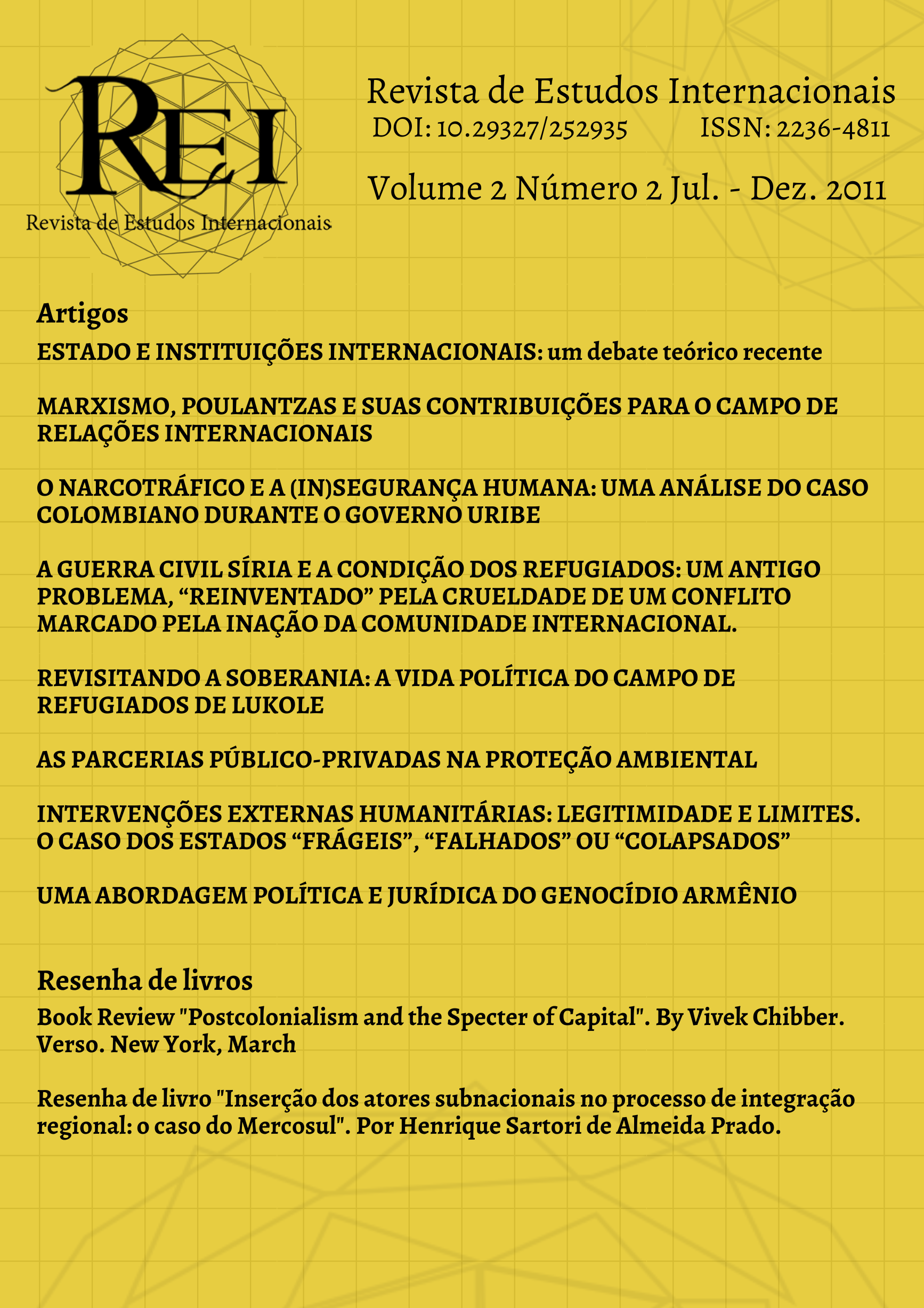ESTADO E INSTITUIÇÕES INTERNACIONAIS: um debate teórico recente
Palavras-chave:
Instituições Internacionais, Teoria das Relações Internacionais, Sistema InternacionalResumo
As instituições internacionais ganharam densidade e importância no cenário mundial principalmente após o fim da Guerra Fria. Os temas sobre cooperação se tornaram comuns nas agendas externas dos Estados. Nesse sentido, compreender o papel das instituições globais e qual o seu peso no comportamento e na orientação dos atores internacionais torna-se relevante. O presente artigo busca apresentar as diferentes abordagens teóricas das Relações Internacionais sobre instituições internacionais, compreendidas como organismos, regimes, valores, normas e práticas entre os Estados e a sociedade internacional. Para isso, serão abordadas as principais correntes teóricas dando ênfase ao debate mais recente passando pelo realismo, o liberalismo, o marxismo e teoria crítica, e o construtivismo, levantando aspectos sobre as instituições internacionais.
Referências
ADLER, E. (1999). “O construtivismo no estudo das relações internacionais”, Lua Nova,
n.47, p.201-246.
ALKER, H.; BIERSTEKER, T. (1984). “The Dialectics of World Order: notes for a future
archeologist of International Savoir Faire”, International Studies Quarterly, v. 28, p. 121-
ARON, R. (2002). Paz e guerra entre as nações. Trad. Sérgio Bath (1ª edição) Brasília:
Editora Universidade de Brasília, Instituto de Pesquisa de Relações Internacionais; São
Paulo: Imprensa Oficial do Estado de São Paulo.
ASHLEY, R. (1986). “The poverty of neorealism”. In: KEOHANE, Robert O. (editor).
Neorealism and its critics. Columbia University Press, New York.
BULL, H. (2002). A sociedade anárquica: Trad. Sérgio Bath (1a
edição) Brasília: Editora
Universidade de Brasília, Instituto de Pesquisa de Relações Internacionais: São Paulo:
Imprensa Oficial do Estado de São Paulo.
CHEKEL, J. (1998). “The Constructivist Turn in International Relations Theory”, World
Politics, v. 50, n. 2, p. 324-348.
COX, R. W. “Social forces, States and World Orders: beyond international relations theory”.
In: KEOHANE, Robert (1986). Neorealism and its critics. Columbia University Press, New
York.
COX, R. W.; SINCLAIR, T. (1999). Approaches to world order. Cambridge University
Press, Cambridge.
ESTEVES, P. L. (org.). (2003). Instituições Internacionais: segurança, comércio e
integração. Belo Horizonte: PUC-Minas.
GOWAN, P. (2006). “A radical realist”. New Left Review. N. 41, Second Series, London.
GUZZINI, S. (2000). “A Reconstruction of Constructivism in International Relations”,
European Journal of International Relations, v. 6, n. 2, p. 147–182.
HALLIDAY, F. (1995). “International Relations and its Discontents”, International Affairs,
Vol. 71.
KATZENSTEIN, P; KEOHANE, R.; KRASNER, S. (1998). “International Organization and
the Study of World Politics”, International Organization, v. 52, n. 4, pp. 645-685.
KEOHANE, R. O., MARTIN, L. (1995). “The Promise of Institutionalist Theory”,
International Security, v. 20, n. 1, p. 39-51.
KEOHANE, R.; NYE Jr, J. (1998). “Power and Interdependence in the Information Age”.
Foreign Affairs, v. 77, nº 5, set/out, Council of Foreign Relations.
__________. (1989). Power and Interdependence. 2
a
ed. Harper Collins.
LAPID, Y. (1989). “The Third Debate: On the Prospects of International Theory in a PostPositivist Era”, International Studies Quarterly, v. 33, n. 3, p. 235-254.
MÁRMORA, L. (1986). El concepto socialista de nación. Ediciones Pasado y Presente:
México.
MARX, K. O Dezoito Brumário de Luiz Bonaparte. In: MARX, K; ENGELS, F. Obras
escolhidas. Vol.1. São Paulo: Editora Alfa-Omega.
MARX, K.; ENGELS, F. O Manifesto Comunista. Tradução Maria Lucia Como. Edição
Especial. Rio de Janeiro: Nova Fronteira, Saraiva de Bolso.
MEARSHEIMER, J. (1994). “The False Promise of International Institutions”, International
Security, v. 19, n. 3, p. 5-49.
__________ (2001). The Tragedy of Great Power Politics. New York: Norton.
MESSARI, N.; NOGUEIRA, J. P. (2005). Teoria das Relações Internacionais: correntes e
debates. Rio de Jaaneiro: Elsevier.
MURPHY, C. (1994). International Organization and Industrial change. Global governance
since 1850. Polity Press: Cambridge.
NYE, J. N. (2009). Cap.6 Conflitos depois da Guerra Fria: intervenção e instituições. In:
Cooperação e conflito nas relações internacionais. São Paulo: Editora Gente.
ONUF, N. (2002). “Institutions, Intentions and International Relations”. Review of
International Studies, v. 28, n. 2, p. 211-228.
ROSENBERG, J. (1994). The empire of civil society. A critique of the realist theory of
international relations. Verso: London.
SCHROEDER, P. (1994). “Historical Reality vs. Neo-Realist Theory”, International
Security, v. 19, n. 1, p. 108-148
VIGEVANI, T. et. al. (2011). “A contribuição marxista para o estudo das relações
internacionais”. IN: Lua Nova, nº 83, p. 111-143.
WALLERSTEIN, I. (1979). El modern sistema mundial. México: Siglo Veintiuno editores.
__________. (2002). Após o Liberalismo: em busca da construção do mundo. Petrópolis, RJ:
Vozes.
WALTZ, K. (2000). “Structural Realism after the Cold War”, International Security, v. 25,
n.1, p. 5-41.
WENDT, A. (2001). “Driving with the Rearview Mirror: On the Rational Science of
Institutional Design”. International Organization, v. 55, n. 4, p. 1019-1049.
__________. (1987). “The Agent-Structure Problem in International Relations”,
International Organization, v. 41, n. 3, p. 335-370.


